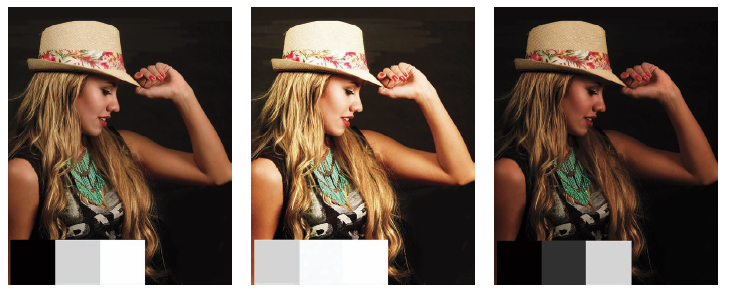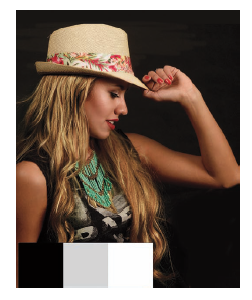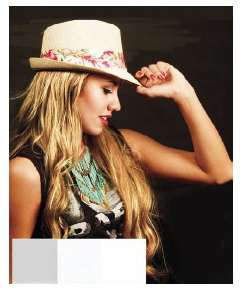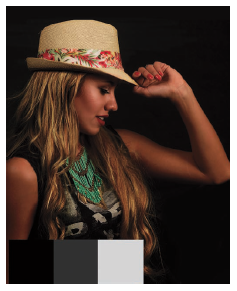
Although it can make some good guesses based on how the brightness levels vary within a scene, your D7200 has no way of knowing for sure what it’s pointed at. So, it must make some assumptions and calculate the correct exposure based on its internal rules. One parameter is that the brightness of all—or part—of a scene will average down to a so-called middle gray tone. The conventional wisdom is that this tone is roughly 18-percent gray. Unfortunately, while the traditional 18-percent value is a middle gray in terms of what the eye sees, the D7200 is actually calibrated for a slightly darker tone. This post explains how your D7200 decides on an exposure in one of its semi-automatic (non-manual) modes.
The exposure is measured using a specific pattern of exposure measuring points that you can select (more on that later). Exposure is calculated based on the assumption that each area being measured reflects about the same amount of light as a neutral gray card that reflects a “middle” gray of about 12- to 18-percent reflectance. (The photographic “gray cards” you buy at a camera store have an 18-percent gray tone. Your camera is calibrated to interpret a somewhat darker 12 percent gray; I’ll explain more about this later, too.) That “average” 12- to 18-percent gray assumption is necessary, because different subjects reflect different amounts of light. In a photo containing, say, a white cat and a dark gray cat, the white cat might reflect five times as much light as the gray cat. An exposure based on the white cat will cause the gray cat to appear to be black, while an exposure based only on the gray cat will make the white cat washed out.
This is more easily understood if you look at some photos of subjects that are dark (they reflect little light), those that have predominantly middle tones, and subjects that are highly reflective. The figures here show a simplified scale with a middle gray 18-percent tone, plus black and white patches, along with a human figure (not a cat) to illustrate how different exposure measurements actually do affect an exposure.
Correctly Exposed
The image shown in Figure 1 represents how a photograph might appear if you inserted the patches shown at bottom left into the scene, and then calculated exposure by measuring the light reflecting from the middle gray patch, which, for the sake of illustration, we’ll assume reflects approximately 12 to 18 percent of the light that strikes it. The exposure meter in the D7200 sees an object that it thinks is a middle gray, calculates an exposure based on that, and the patch in the center of the strip is rendered at its proper tonal value. Best of all, because the resulting exposure is correct, the black patch at left and white patch at right are rendered properly as well.
When you’re shooting pictures with your D7200, and the meter happens to base its exposure on a subject that averages that “ideal” middle gray, then you’ll end up with similar (accurate) results. The camera’s exposure algorithms are concocted to ensure this kind of result as often as possible, barring any unusual subjects (that is, those that are backlit, or have uneven illumination). The D7200 has three metering modes, each of which is equipped to handle certain types of unusual subjects.

When exposure is calculated based on the middle-gray tone in the center of the card,
the black and white patches are rendered accurately, too, and our model is properly exposed.
Overexposed
Figure 2 shows what would happen if the exposure were calculated based on metering the leftmost, black patch. The light meter sees less light reflecting from the black square than it would see from a gray middle-tone subject, and so figures, “Aha! I need to add exposure to brighten this subject up to a middle gray!” That lightens the “black” patch, so it now appears to be gray.
But now the patch in the middle that was originally middle gray is overexposed and becomes light gray. And the white square at right is now seriously overexposed and loses detail in the highlights, which have become a featureless white. Our human subject is similarly overexposed.

When exposure is calculated based on the black square at lower left, the black patch looks gray, the gray patch appears to be a light gray, and the white square is seriously overexposed.
Underexposed
The third possibility in this simplified scenario is that the light meter might measure the illumination bouncing off the white patch, and try to render that tone as a middle gray (Figure 3). A lot of light is reflected by the white square, so the exposure is reduced, bringing that patch closer to a middle gray tone. The patches that were originally gray and black are now rendered too dark. Clearly, measuring the gray card—or a substitute that reflects about the same amount of light—is the only way to ensure that the exposure is precisely correct.

When exposure is calculated based on the white patch on the right, the other two patches, and the photo, are underexposed
This excerpt was taken from David Busch’s D7200 Guide to Digital SLR Photography.
